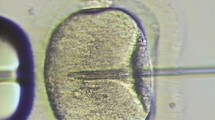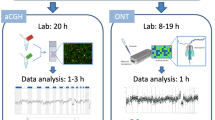Abstract
ALL available information on the chromosome constitution of human gametes is speculative, having been obtained by inference from the chromosome constitution of conceptuses that survive sufficiently long to produce a clinically recognisable pregnancy. A minimum of 10% of all recognised human conceptions are chromosomally abnormal, and it has been estimated that 1–2% are the result of fertilisation by a spermatozoon with a chromosome abnormality1. Cytological evaluation of the chromosome constitution of human spermatozoa has been restricted to the staining of fixed smears of whole sperm2–13. Certain chromosome regions with peculiar staining properties, such as the long arm of the Y chromosome and the heterochromatic region of chromosome 9, are presumed to be represented in appropriately stained sperm nuclei by differentially staining spots. By counting the number of these spots per nucleus, the frequency of aneuploidy in the sperm of normal males has been estimated to be around 40% (refs 5, 9–11). The precision of the data obtained from stained whole sperm is dubious, because several factors must be taken into consideration when blobs are counted in sperm head nuclei, all of which could contribute to biased estimates of nondisjunction7,8,12. For this reason, some claims have now been retracted12,13. To investigate the true contribution of male gametes to the production of chromosomally abnormal conceptuses and the factors influencing the production and survival of chromosomally abnormal sperm, it is necessary to analyse the sperm chromosomes directly. However, after meiotic metaphase II sperm chromosomes do not reappear until the male and female pronuclei of the fertilised egg prepare for the first cleavage division. We report here the use of hamster eggs to activate human sperm to the point where their chromosomes can be studied directly.
Similar content being viewed by others
References
Jacobs, P. A. in Proc. Int. Symp., The Genetics of the Spermatozoon (eds Beatty, R. A. & Gluecksohn-Waelsh, S.) 346–358 (Edinburgh, 1971).
Pearson, P. L. & Bobrow, M. J. Reprod. Fert. 22, 177–179 (1970).
Barlow, P. & Vosa, C. G. Nature 226, 961–962 (1970).
Sumner, A. T., Robinson, J. A. & Evans, H. J. Nature new Biol. 229, 231–233 (1971).
Pawlowitzki, I. H. & Pearson, P. L. Humangenetik 16, 119–122 (1972).
Beatty, R. A. Biol. J. Linnean Soc. 7, Suppl. 1, 291–299 (1975).
Roberts, A. M. & Goodall, H. Nature 262, 493–494 (1976).
Schwinger, E., Ites, J. & Korte, B. Hum. Genet. 34, 265–270 (1976).
Pearson, P. L., Geraedts, J. P. M. & Pawlowitzki, I. H. in Les Accidents Chromosomiques de la Reproduction (eds Boué, A. & Thibault, C.) 219–229 (INSERM, Paris, 1973).
Geraedts, J. & Pearson, P. Bull. Eur. Soc. hum. Genet. 24–31 (1973).
Evans, H. J. in Proc. Int. Symp., The Genetics of the Spermatozoon (eds Beatty, R. A. & Gluecksohn-Waelsh, S.) 144–159 (Edinburgh, 1971).
Beatty, R. A. Cytogenet. Cell Genet. 18, 33–49 (1977).
Sumner, A. T. & Robinson, J. A. J. Reprod. Fert. 48, 9–15 (1976).
Sawicki, W. & Koprowski, H. Expl Cell Res. 66, 145–151 (1971).
Phillips, S. G. & Phillips, D. M. J. Cell Biol. 63, 269a (1974).
Bendich, A., Borenfreund, E. & Sternberg, S. S. Science 183, 857–859 (1974).
Elsevier, S. M. & Ruddle, F. H. Chromosoma 56, 227–241 (1976).
Johnson, R. T., Rao, P. N. & Hughes, H. D. J. Cell Physiol. 76, 151–158 (1970).
Gledhill, B. L., Sawicki, W., Croce, C. M. & Koprowski, H. Expl Cell Res. 73, 33–40 (1972).
Yanagimachi, R., Yanagimachi, H. & Rogers, B. J. Biol. Reprod. 15, 471–476 (1976).
Biggers, J. D., Whitten, W. K. & Whittingham, D. G. in Methods in Mammalian Embryology (ed. Daniel, J. C. Jr) 86 (Freeman, San Francisco, 1971).
Knowland, J. & Graham, C. J. Embryol. exp. Morph. 27, 167–176 (1978).
Tarkowski, A. K. Cytogenetics 5, 394–400 (1966).
Sumner, A. T. Expl Cell Res. 75, 304–306 (1972).
Author information
Authors and Affiliations
Rights and permissions
About this article
Cite this article
RUDAK, E., JACOBS, P. & YANAGIMACHI, R. Direct analysis of the chromosome constitution of human spermatozoa. Nature 274, 911–913 (1978). https://doi.org/10.1038/274911a0
Received:
Accepted:
Issue Date:
DOI: https://doi.org/10.1038/274911a0
- Springer Nature Limited
This article is cited by
-
Comprehensive chromosome FISH assessment of sperm aneuploidy in normozoospermic males
Journal of Assisted Reproduction and Genetics (2022)
-
Chromosomal scan of single sperm cells by combining fluorescence-activated cell sorting and next-generation sequencing
Journal of Assisted Reproduction and Genetics (2019)
-
Detection of DNA fragmentation and meiotic segregation in human with isolated teratozoospermia
Journal of Assisted Reproduction and Genetics (2011)
-
Chromosomal integrity and DNA damage in freeze‐dried spermatozoa
Reproductive Medicine and Biology (2011)





